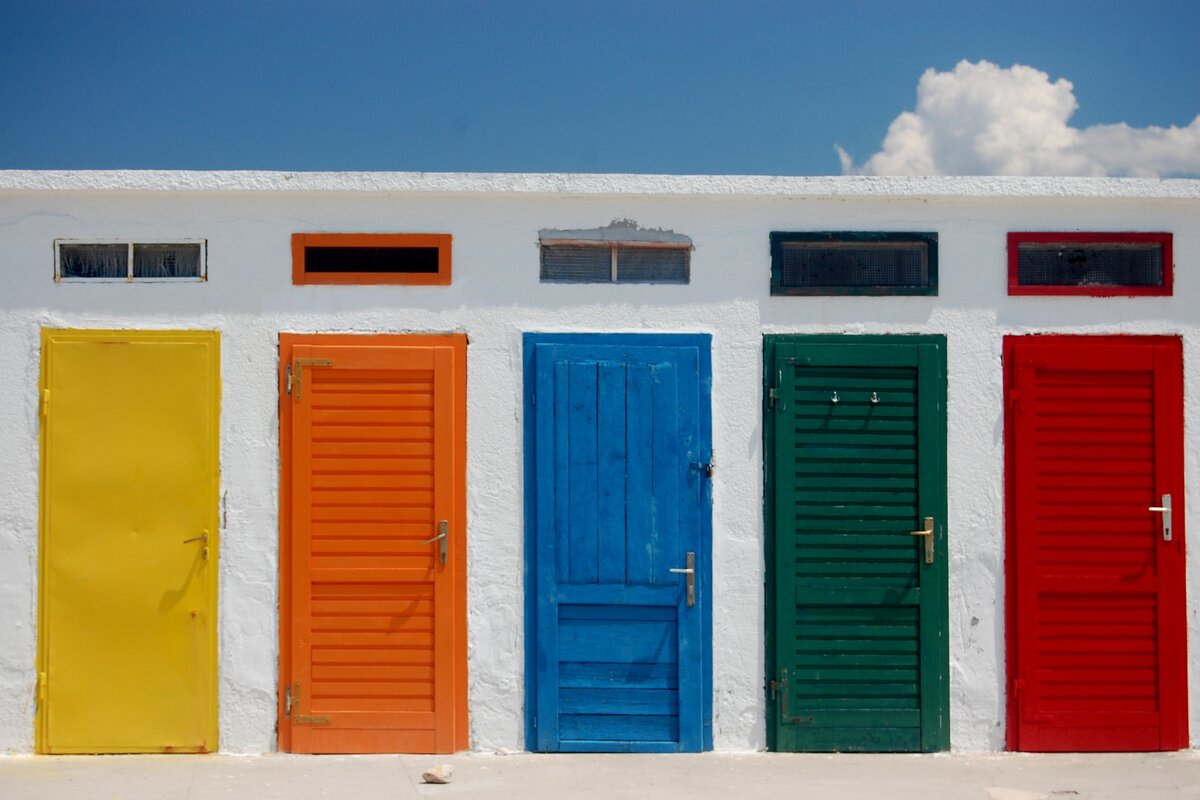
Your front door is your home’s first line of defense against weather, as well as a focal point for curb appeal. So what kind of paint is best for front doors? That depends on the type of door.
We’ll explain that and more — like whether you should prime or not — in this article.
Table of Contents
- Best Paints for Each Type of Door
- Gloss, Semigloss or Something Else?
- Why Front Door Paint Matters
- To Prime or Not to Prime
- FAQ
Best Paints for Each Type of Door
Exterior door paint mostly comes in two water-based varieties, acrylic resin or latex-based, as well as oil-based. Here’s a closer look at each paint type:
- Latex-Based Paints: Among latex paint’s chief characteristics is its ability to be rapidly applied to a surface and dry quickly. It also provides weather-resistant coverage and rust protection, if the door is metal. Latex paint also gives off fewer fumes, so it is safer to use and cleans up with soap and water better than acrylic or oil paints.
- Acrylic Resin Paints: Acrylic resin paints are generally more expensive but tend to be longer lasting, balancing the higher cost. What makes acrylic paint special? The chemicals in acrylic resin paint are somewhat elastic, so the paint will expand and contract as temperatures go up and down. This characteristic of acrylic paint tends to minimize the amount of flaking and cracking on an exterior door.
Similarly, If sunlight on the door is an issue, acrylic paint resists sun-induced fading better than latex or oil paints. - Oil-Based Paints: Oil-based paint is thicker and takes longer to apply and longer to dry. But for woods that allow tannin bleed-through like redwood, cypress and cedar, oil-based paint is the best choice because it resists the tannins and minimizes bleeding.
Here are the paints that work best for each door material:
Wood
Front door wood can be divided into two classes – woods that bleed (redwood, cypress and cedar are examples) and woods that do not bleed (pine and white fir, for example).
- Water-based exterior paint works well on woods that DO NOT bleed (that’s to say, do not release compounds known as tannins). Tannins can seep into water-based paint, leaving yellowish-brown discoloration when the job is done.
- Oil-based exterior paint is the better choice for woods that bleed, like redwood, cypress or cedar. Oil-based paints aren’t as susceptible to tannin bleeding.
Metal
The first thing to know about painting metal doors is they are not porous. What this means: No matter what paint you choose, it will not be absorbed into the door as wood would.
When working with metal doors, it’s best to go with an oil-based paint that prevents rust. As with most DIY projects, preparation is vital. You might think you’d be spared sanding with metal doors, but no. You’ll want to sand off the previous color. More than that, you will want to degrease the door before painting to ensure you don’t get a rough texture when you’re done.
Fiberglass
Fiberglass doors do well with a water-based paint. This paint is both thinner and less sticky than oil-based paint and will go onto the fiberglass more easily. More than that, oil-based paints can be harmful to fiberglass.
Sanding generally isn’t needed ahead of painting fiberglass doors, but thorough cleaning with soap and water is. You should follow by towel drying, then an hour or two air drying. Then you’ll be ready to resume.
Gloss, Semi-Gloss or Something Else?

What luster of paint do you want on your front door?
While exterior paints are available like flat/matte, eggshell, satin, semi-gloss and gloss sheens — ranked in order from the lowest to the highest luster — semi-gloss is by far the primary choice for application on front doors.
Semi-Gloss
As the de facto standard for exterior doors, semi-gloss is wear- and stain-resistant as opposed to flatter sheens. Semi-gloss paint also is more reflective, meaning it wipes clean. It also masks imperfections in the door better than a higher-gloss sheen.
Gloss
Gloss paint is the shiniest option and makes a positive difference in rich, dark colors. But for that to be the case, the surface must be sanded, filled and smoothed out, because the light hitting gloss finishes will show imperfections.
Why Door Paint Matters
Your door stands firm against outdoor elements, including sun, wind, rain and perhaps snow. There are bumps from carrying groceries inside, moving in furniture, etc. All that takes a toll in the form of dents, dings, scratches and smudges over time.
A door covered with a fresh coat of paint will hide those imperfections while making a good first impression. If your door faces harsh sunlight day after day, the paint you choose can resist fading from the sun’s UV rays. If rain or snow are a problem, there are paints specifically designed to fight off mold and mildew.
More than that, a new coat of paint can say something about you. For those who explore the language of color, think about the message you want your front door to send.
- Blue is a soothing color, so they say.
- Red, orange and yellow are friendly and inviting hues.
- White suggests a feeling of simplicity.
- Purple can be adventurous.
- Black is clean and can be chic.
- Green and brown are neutral colors that blend nicely with trees, flowers and other foliage.
Pick the color that feels right for you and what you want your home to say to your family and visitors.
To Prime or Not to Prime
You have two options. You can prime, then paint. Or you can skip the prime and paint with a product that is a combination of primer and paint.
The second option is undoubtedly easier, as you’ll cut your work in half. However, a paint-and-primer combination isn’t the best for all situations.
If your front door is new or is in good condition and doesn’t need a lot of touch-ups, or if you are painting the door the same color, the paint-and-primer combination should work fine.
Stained doors, doors that need to have cracks or gaps filled, doors that are worn and peeling, and doors that you want to transition from a dark color to a lighter one are best served with primer applied separately before the paint.
In cold climates, the primer can be more important than the paint, as a high-adhesion primer will help the paint adhere to the door, which will last longer when the temperatures get low. Special “cold-set” paints are on the market designed to endure cold temperatures.
FAQ About Front Door Painting
When is it time to paint the front door?
It’s time to paint your front door if you just want to change the look of your home. It’s also a good time if the front door is showing cracks or is flaking or is chipped along the edges. Similarly, if the current coat of paint is fading badly thanks to the sun and weather, it’s a good time to get on the job.
When is the best time to paint your front door?
Spring and fall are the best times to paint your front door.
When is the best time of day to paint your front door?
You’ll likely want to have the door off the hinges for a minimal amount of time, so starting early in the day when the hours are long in the spring is particularly ideal. That gives the door time to dry, the door hardware can be reattached, and the door reinstalled before the sun goes down.
DIY or Hire a Professional Painter?
DIY: If you’re reasonably experienced at painting, you can paint your own front door, but you might need some help if the door has to be taken down. That extra set of hands will help ensure the door fits precisely when it’s time to rehang it after painting and drying.
Hire a Pro: If you’d rather not get your paint on the door, your hands, your face, and your front porch or steps, Paint Gnome connects you to the best painting professionals near you. With a few clicks, you’ll get quotes in minutes. Even better? You’ll know your front door will look great afterward.
Main Photo by: Rawpixel